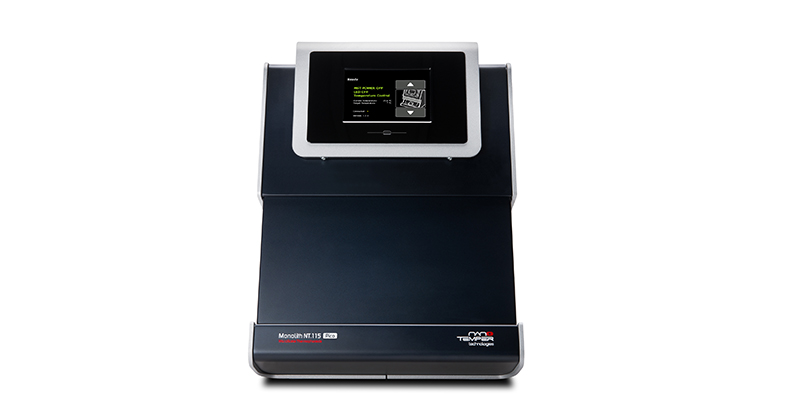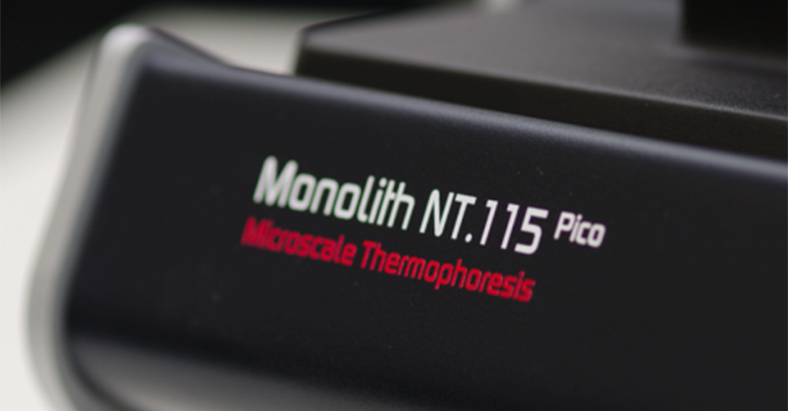MO NT.115Pico 系列仪器用于各种生物分子的相互作用测试,包括pM级别亲和力的样品。

Monolith NT.115pico配置高灵敏检测器,能够检测到浓度低至10 pM的红色荧光染料,可用于分析解离常数低至1pM的极高生物分子亲和力。测试时可以使用复杂的生物液体如裂解物或血清,可以在接近天然,免纯化条件下测解离常数。NT.115pico 的 pico 检测器配有一个高度优化的荧光通道:pico-红。
主要特点:
1. 超宽检测范围:解离常数pM – mM
2. 超高灵敏度:只需10 µl 荧光分子
3. 样品消耗低:每个滴定点只需4 µl
4. 免纯化,可在细胞裂解液或血清中进行
5. 分子大小无限制:小到低分子量分子间,大到核糖体间的结合均可检测
6. 数分钟内获得Kd值
7. Kd-plus:获得Kd值同时附加样品性质和聚集情况信息
8. 免维护
9. 操作方便:样品准备简单,软件界面友好直观
"We are exploring new horizons of this software and discover its great potential in the advanced characterization of biologics"

"It allows us to quickly obtain critical data on protein characteristics and stability early within the development process"

"We are exploring new horizons of this software and discover its great potential in the advanced characterization of biologics"

"It allows us to quickly obtain critical data on protein characteristics and stability early within the development process"

Competitive Assay Approach: Binding of Small Molecules to the Active Form of p38
One-step, purification-free and site-specific labeling of polyhistidine-tagged proteins for MST
Studying the interaction of the antibody-drug conjugate SYD985 with an anti-toxin antibody
Competitive Assay Approach: Binding of Small Molecules to the Active Form of p38
Studying the interaction of membrane enzyme PgIB with substrate and inhibitory peptide
Anaerobic MicroScale Thermophoresis reveals the Redox dependency of ferredoxin in mitochondrial Fe/S biogenesis
Nature
De Dong, Kuan Ren, Xiaolin Qiu, Jianlin Zheng, Minghui Guo, Xiaoyu Guan, Hongnan Liu, Ningning Li, Bailing Zhang, Daijun Yang, Chuang Ma, Shuo Wang, Dan Wu, Yunfeng Ma, Shilong Fan, Jiawei Wang, Ning Gao & Zhiwei Huang
Abstract
The CRISPR-Cas systems, as exemplified by CRISPR-Cas9, are RNA-guided adaptive immune systems used by bacteria and archaea to defend against viral infection. The CRISPR-Cpf1 system, a new class 2 CRISPR-Cas system, mediates robust DNA interference in human cells. Although functionally conserved, Cpf1 and Cas9 differ in many aspects including their guide RNAs and substrate specificity. Here we report the 2.38 Å crystal structure of the CRISPR RNA (crRNA)-bound Lachnospiraceae bacterium ND2006 Cpf1 (LbCpf1). LbCpf1 has a triangle-shaped architecture with a large positively charged channel at the centre. Recognized by the oligonucleotide-binding domain of LbCpf1, the crRNA adopts a highly distorted conformation stabilized by extensive intramolecular interactions and the (Mg(H2O)6)2+ ion. The oligonucleotide-binding domain also harbours a looped-out helical domain that is important for LbCpf1 substrate binding. Binding of crRNA or crRNA lacking the guide sequence induces marked conformational changes but no oligomerization of LbCpf1. Our study reveals the crRNA recognition mechanism and provides insight into crRNA-guided substrate binding of LbCpf1, establishing a framework for engineering LbCpf1 to improve its efficiency and specificity for genome editing.
Keywords
Monolith NT.115, Protein-Nucleic acid
DNA-binding proteins from marine bacteria expand the known sequence diversity of TALE-like repeats
Nucleic Acids Research
Orlando de Lange, Christina Wolf, Philipp Thiel, Jens Krüger, Christian Kleusch,Oliver Kohlbacher, Thomas Lahaye
Abstract
Transcription Activator-Like Effectors (TALEs) of Xanthomonas bacteria are programmable DNA binding proteins with unprecedented target specificity. Comparative studies into TALE repeat structure and function are hindered by the limited sequence variation among TALE repeats. More sequence-diverse TALE-like proteins are known from Ralstonia solanacearum (RipTALs) and Burkholderia rhizoxinica (Bats), but RipTAL and Bat repeats are conserved with those of TALEs around the DNA-binding residue. We study two novel marine-organism TALE-like proteins (MOrTL1 and MOrTL2), the first to date of non-terrestrial origin. We have assessed their DNA-binding properties and modelled repeat structures. We found that repeats from these proteins mediate sequence specific DNA binding conforming to the TALE code, despite low sequence similarity to TALE repeats, and with novel residues around the BSR. However, MOrTL1 repeats show greater sequence discriminating power than MOrTL2 repeats. Sequence alignments show that there are only three residues conserved between repeats of all TALE-like proteins including the two new additions. This conserved motif could prove useful as an identifier for future TALE-likes. Additionally, comparing MOrTL repeats with those of other TALE-likes suggests a common evolutionary origin for the TALEs, RipTALs and Bats.
Keywords
Monolith NT.115, Protein-Nucleic Acids, Biomolecular Interaction, Prometheus NT.48, Protein Stability
Receptor binding by a ferret-transmissible H5 avian influenza virus
Nature
Xiaoli Xiong, Peter J. Coombs, Stephen R. Martin, Junfeng Liu, Haixia Xiao, John W. McCauley, Kathrin Locher, Philip A. Walker, Patrick J. Collins, Yoshihiro Kawaoka, John J. Skehel & Steven J. Gamblin
Abstract
Cell-surface-receptor binding by influenza viruses is a key determinant of their transmissibility, both from avian and animal species to humans as well as from human to human. Highly pathogenic avian H5N1 viruses that are a threat to public health have been observed to acquire affinity for human receptors, and transmissible-mutant-selection experiments have identified a virus that is transmissible in ferrets1, 2, 3, the generally accepted experimental model for influenza in humans. Here, our quantitative biophysical measurements of the receptor-binding properties of haemagglutinin (HA) from the transmissible mutant indicate a small increase in affinity for human receptor and a marked decrease in affinity for avian receptor. From analysis of virus and HA binding data we have derived an algorithm that predicts virus avidity from the affinity of individual HA-receptor interactions. It reveals that the transmissible-mutant virus has a 200-fold preference for binding human over avian receptors. The crystal structure of the transmissible-mutant HA in complex with receptor analogues shows that it has acquired the ability to bind human receptor in the same folded-back conformation as seen for HA from the 1918, 1957 (ref. 4), 1968 (ref. 5) and 2009 (ref. 6) pandemic viruses. This binding mode is substantially different from that by which non-transmissible wild-type H5 virus HA binds human receptor. The structure of the complex also explains how the change in preference from avian to human receptors arises from the Gln226Leu substitution, which facilitates binding to human receptor but restricts binding to avian receptor. Both features probably contribute to the acquisition of transmissibility by this mutant virus.
Keywords
Animals; Birds/metabolism/virology; Chick Embryo; Crystallography, X-Ray; Ferrets/*virology; Hemagglutinin Glycoproteins; Influenza Virus/*chemistry/genetics/*metabolism; *Host Specificity;
Humans; Influenza A Virus; H5N1 Subtype/chemistry/*genetics/*metabolism/pathogenicity; Models, Biological; Models, Molecular; Mutation; Orthomyxoviridae Infections/*transmission/*virology; Protein Conformation; Receptors, Virus/*metabolism; Species Specificity; Monolith NT.115; Protein-Protein
Discovery of Inter-Domain Stabilizers—A Novel Assay System for Allosteric Akt Inhibitors
ACS Chemical Biology
Zhizhou Fang, Jeffrey R. Simard, Dennis Plenker, Hoang D. Nguyen, Trang Phan, Patrik Wolle, Stefan Baumeister, Daniel Rauh
Abstract
In addition to the catalytically active kinase domain, most kinases feature regulatory domains that govern their activity. Modulating and interfering with these interdomain interactions presents a major opportunity for understanding biological systems and developing novel therapeutics. Therefore, small molecule inhibitors that target these interactions through an allosteric mode of action have high intrinsic selectivity, as these interactions are often unique to a single kinase or kinase family. Here we report the development of iFLiK (interface-Fluorescent Labels in Kinases), a fluorescence-based assay that can monitor such interdomain interactions. Using iFLiK, we have demonstrated selective detection of allosteric Akt inhibitors that induce an inactive closed conformation unique to Akt. This methodology easily distinguished small molecule allosteric inhibitors from classic ATP-competitive inhibitors. Screening an in-house compound library with iFLiK, we were able to identify novel compounds with a scaffold that has not been previously described for allosteric Akt inhibitors.
Keywords
Monolith NT.115; Protein-Small Molecule; Biomolecular Interaction
The Combined Repetitive Oligopeptides of Clostridium difficile Toxin A Counteract Premature Cleavage of the Glucosyl-Transferase Domain by Stabilizing Protein Conformation
Toxins
Alexandra Olling, Corinna Hüls, Sebastian Goy, Mirco Müller, Simon Krooss, Isa Rudolf, Helma Tatge, Ralf Gerhard
Abstract
Toxin A (TcdA) and B (TcdB) from Clostridium difficile enter host cells by receptor-mediated endocytosis. A prerequisite for proper toxin action is the intracellular release of the glucosyltransferase domain by an inherent cysteine protease, which is allosterically activated by inositol hexaphosphate (IP6). We found that in in vitro assays, the C-terminally-truncated TcdA1–1065 was more efficient at IP6-induced cleavage compared with full-length TcdA. We hypothesized that the C-terminally-located combined repetitive oligopeptides (CROPs) interact with the N-terminal part of the toxin, thereby preventing autoproteolysis. Glutathione-S-transferase (GST) pull-down assays and microscale thermophoresis confirmed binding between the CROPs and the glucosyltransferase (TcdA1–542) or intermediate (TcdA1102–1847) domain of TcdA, respectively. This interaction between the N- and C-terminus was not found for TcdB. Functional assays revealed that TcdB was more susceptible to inactivation by extracellular IP6-induced cleavage. In vitro autoprocessing and inactivation of TcdA, however, significantly increased, either by acidification of the surrounding milieu or following exchange of its CROP domain by the homologous CROP domain of TcdB. Thus, TcdA CROPs contribute to the stabilization and protection of toxin conformation in addition to function as the main receptor binding domain.
Keywords
Monolith NT.115; Protein-Protein; Biomolecular Interaction
Competition between MPS1 and microtubules at kinetochores regulates spindle checkpoint signaling
Science
Abstract
Cell division progresses to anaphase only after all chromosomes are connected to spindle microtubules through kinetochores and the spindle assembly checkpoint (SAC) is satisfied. We show that the amino-terminal localization module of the SAC protein kinase MPS1 (monopolar spindle 1) directly interacts with the HEC1 (highly expressed in cancer 1) calponin homology domain in the NDC80 (nuclear division cycle 80) kinetochore complex in vitro, in a phosphorylation-dependent manner. Microtubule polymers disrupted this interaction. In cells, MPS1 binding to kinetochores or to ectopic NDC80 complexes was prevented by end-on microtubule attachment, independent of known kinetochore protein-removal mechanisms. Competition for kinetochore binding between SAC proteins and microtubules provides a direct and perhaps evolutionarily conserved way to detect a properly organized spindle ready for cell division.
Keywords:
Monolith NT.115, Protein-Protein, Multiple Component Interactions, Biomolecular Interaction
Competition between MPS1 and microtubules at kinetochores regulates spindle checkpoint signaling
Science
Abstract
Cell division progresses to anaphase only after all chromosomes are connected to spindle microtubules through kinetochores and the spindle assembly checkpoint (SAC) is satisfied. We show that the amino-terminal localization module of the SAC protein kinase MPS1 (monopolar spindle 1) directly interacts with the HEC1 (highly expressed in cancer 1) calponin homology domain in the NDC80 (nuclear division cycle 80) kinetochore complex in vitro, in a phosphorylation-dependent manner. Microtubule polymers disrupted this interaction. In cells, MPS1 binding to kinetochores or to ectopic NDC80 complexes was prevented by end-on microtubule attachment, independent of known kinetochore protein-removal mechanisms. Competition for kinetochore binding between SAC proteins and microtubules provides a direct and perhaps evolutionarily conserved way to detect a properly organized spindle ready for cell division.
Keywords:
Monolith NT.115, Protein-Protein, Multiple Component Interactions, Biomolecular Interaction
Nature
De Dong, Kuan Ren, Xiaolin Qiu, Jianlin Zheng, Minghui Guo, Xiaoyu Guan, Hongnan Liu, Ningning Li, Bailing Zhang, Daijun Yang, Chuang Ma, Shuo Wang, Dan Wu, Yunfeng Ma, Shilong Fan, Jiawei Wang, Ning Gao & Zhiwei Huang
Abstract
The CRISPR-Cas systems, as exemplified by CRISPR-Cas9, are RNA-guided adaptive immune systems used by bacteria and archaea to defend against viral infection. The CRISPR-Cpf1 system, a new class 2 CRISPR-Cas system, mediates robust DNA interference in human cells. Although functionally conserved, Cpf1 and Cas9 differ in many aspects including their guide RNAs and substrate specificity. Here we report the 2.38 Å crystal structure of the CRISPR RNA (crRNA)-bound Lachnospiraceae bacterium ND2006 Cpf1 (LbCpf1). LbCpf1 has a triangle-shaped architecture with a large positively charged channel at the centre. Recognized by the oligonucleotide-binding domain of LbCpf1, the crRNA adopts a highly distorted conformation stabilized by extensive intramolecular interactions and the (Mg(H2O)6)2+ ion. The oligonucleotide-binding domain also harbours a looped-out helical domain that is important for LbCpf1 substrate binding. Binding of crRNA or crRNA lacking the guide sequence induces marked conformational changes but no oligomerization of LbCpf1. Our study reveals the crRNA recognition mechanism and provides insight into crRNA-guided substrate binding of LbCpf1, establishing a framework for engineering LbCpf1 to improve its efficiency and specificity for genome editing.
Keywords
Monolith NT.115, Protein-Nucleic acid
DNA-binding proteins from marine bacteria expand the known sequence diversity of TALE-like repeats
Nucleic Acids Research
Orlando de Lange, Christina Wolf, Philipp Thiel, Jens Krüger, Christian Kleusch,Oliver Kohlbacher, Thomas Lahaye
Abstract
Transcription Activator-Like Effectors (TALEs) of Xanthomonas bacteria are programmable DNA binding proteins with unprecedented target specificity. Comparative studies into TALE repeat structure and function are hindered by the limited sequence variation among TALE repeats. More sequence-diverse TALE-like proteins are known from Ralstonia solanacearum (RipTALs) and Burkholderia rhizoxinica (Bats), but RipTAL and Bat repeats are conserved with those of TALEs around the DNA-binding residue. We study two novel marine-organism TALE-like proteins (MOrTL1 and MOrTL2), the first to date of non-terrestrial origin. We have assessed their DNA-binding properties and modelled repeat structures. We found that repeats from these proteins mediate sequence specific DNA binding conforming to the TALE code, despite low sequence similarity to TALE repeats, and with novel residues around the BSR. However, MOrTL1 repeats show greater sequence discriminating power than MOrTL2 repeats. Sequence alignments show that there are only three residues conserved between repeats of all TALE-like proteins including the two new additions. This conserved motif could prove useful as an identifier for future TALE-likes. Additionally, comparing MOrTL repeats with those of other TALE-likes suggests a common evolutionary origin for the TALEs, RipTALs and Bats.
Keywords
Monolith NT.115, Protein-Nucleic Acids, Biomolecular Interaction, Prometheus NT.48, Protein Stability

 More than binding affinities
More than binding affinities





